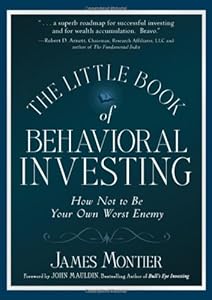Learning about traits that make us bad investors has been an enlightening but uncomfortable sojourn. Uncomfortable because too often, I’m guilty of the very behavior Montier discourages. A lifetime of bad habit is hard to correct! But the quality Montier explores in Chapter 15 of The Little Book of Behavioral Investing: How not to be your worst enemy will, I believe, prove the hardest of them all.

Have you heard the story of a speaker addressing a large crowd and saying “Half the people here are stupid.” Not surprisingly, the audience roars in resentment. He reframes, “Half the people here are intelligent.” The crowd is mollified though the implication of both statements is the same.
“Loss aversion,” the topic under discussion, has a similar psychological premise. Even professional golfers and capuchin monkeys suffer this weakness; not that they’re comparable but Montier gives us illustrative examples of both. Let me share the primate story with you.
An experiment was conducted where two testers played a game with capuchins:
Case 1: Give the monkey a grape. Flip a coin. On one outcome (heads or tails), give a bonus grape to the monkey.
Case 2: Give the monkey two grapes (bonus). Flip a coin. On one outcome, take one grape away from the monkey.
Case 1 is positioned as a gain and Case 2 as a loss. Even though both will lead to the monkey winning or at least retaining two grapes at a 50% probability, the capuchins returned predominately to the first experimenter. They exhibited loss aversion. And we’ve not evolved enough to get rid of this bias.
But it’s not just loss aversion that plays with our judgment. We are also blessed with a myopic point of view, making us too focused on the short-term. It’s why so many traders glue their eyes to online stock dashboards, watching stock prices every second. If you’re one of this group and still not a nervous wreck, hear this: You’ve got it wrong.

It’s unpractical to expect your portfolio stocks to do well in the short-term. Joel Greenblatt who advises investors to follow his magic formula recalls that “the magic formula portfolio fared poorly relative to the market average in five out of every 12 months tested. For full year periods the magic formula portfolio failed to beat the market average once every four years.” But it produced long-term gain.
You’d think loss aversion would have us cutting our losses wherever possible. But that’s not the case. There’s a distinct difference in behavior “after loss” versus the “risk of incurring a loss”. People don’t believe a loss will materialize till it actually hits them. This is the disposition effect. It’s why investors stick with stocks they’d do better to sell.
The endowment effect – the tendency to overvalue something when we own it – makes it worse. A losing stock on my portfolio? There’s hope yet. A losing stock in the market? Stay away.
Here are some startling facts from Terry Odean’s examination of data from a discount brokerage:
- Investors held losing stocks for a median of 124 days versus 102 days for winning stocks.
- On average, individual investors sold 15% of all winning positions and only 9% of all losing positions.
- Winners sold outperformed losers that continued to be held by an average of 3.4% per annum.
This is loss aversion at work compounded by over-optimism, over-confidence and the self-attribution bias. And these stats hold good for both professional and individual investors.
The solution again is the resilient investment plan covered in Chapter 2. Stop losses alleviate the disposition effect in that selling or buying decisions are preempted by prior valuations rather than volatile data and reports. Of course, you must distinguish between cigar-butt stocks and compounders here. The former category includes stocks bought real cheap and sold when they’re near their intrinsic value. The latter is stocks that will gain intrinsic value over a longer period. These are the ones to stick with.
So, sometimes you take a call when new data comes up. But most times, you stick with your investment plan and sell at the right time.
Monica Samuel is doing a chapter-wise review of the book: The Little Book of Behavioral Investing: How not to be your worst enemy by James Montier. You can follow the series by following this tag: tlbbinvesting or by subscribing to this rss feed: tlbbifeed













